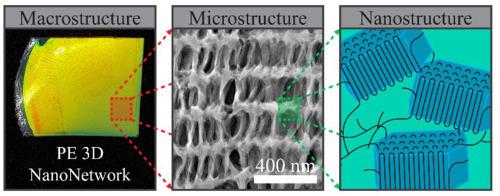Polymer ( IF 4.6 ) Pub Date : 2020-10-15 , DOI: 10.1016/j.polymer.2020.123145 Pedro M. Resende , Edgar Gutiérrez-Fernández , Myriam H. Aguirre , Aurora Nogales , Marisol Martín-González

|
Polymers occupy a central role in current society due to their utility and versatile properties. As part of the class of soft materials, polymers have also been employed in research through nanostructuration and functionalization, looking for the development of new metamaterials with wide applicability in science and society. A particular polymer, Polyethylene, has been widely used both in research and commodities, and new ways to nanostructure and improve its functionality should be considered. Here, we report on the nanostructuration of polyethylene for the fabrication of three-dimensional nanonetworks, by resorting to 3 different variants of polyethylene: low density, high density, and ultra-high molecular weight. Through the melt infiltration of these polymers into well-known three-dimensional interconnected anodic aluminum oxide templates (3D-AAO), a study can be performed to understand the effects of the chain length, structure, and chain-branching of the used polymers on the stability and integrity of the resulting polymeric nanonetworks. This was accomplished by performing infiltrations in the presence of excess bulk material and quenching the infiltration process to access transient infiltration stages. The morphology of these networks was analysed through SEM and STEM-HAADF to understand the differences arising from polymer structure. The observed results are interpreted through the use of the Lucas-Washburn equation for capillary flow and the determination of the critical contact angle for spontaneous capillary infiltration. The resulting metamaterials also exhibit photonic responses, resulting from the replication of the periodic nature of the employed templates.
中文翻译:

聚乙烯三维纳米网络:横向链如何影响超材料的形成。
聚合物由于其实用性和通用性而在当今社会中起着核心作用。作为软材料类别的一部分,聚合物还通过纳米结构化和功能化被用于研究中,以寻求开发在科学和社会中具有广泛适用性的新型超材料。一种特殊的聚合物,聚乙烯,已广泛用于研究和商品领域,应考虑采用新方法来纳米结构和改善其功能。在这里,我们报告了聚乙烯的纳米结构,用于制造三维纳米网络,方法是诉诸聚乙烯的3种不同变体:低密度,高密度和超高分子量。通过将这些聚合物熔融渗透到众所周知的三维互连的阳极氧化铝模板(3D-AAO)中,可以进行一项研究以了解所用聚合物的链长,结构和链支化对所得聚合物纳米网络的稳定性和完整性。这是通过在过量散装物料存在下进行渗透并淬灭渗透过程以进入瞬时渗透阶段来实现的。通过SEM和STEM-HAADF分析了这些网络的形态,以了解聚合物结构产生的差异。观察到的结果通过使用Lucas-Washburn方程用于毛细流动和确定自发毛细渗透的临界接触角来解释。



























 京公网安备 11010802027423号
京公网安备 11010802027423号